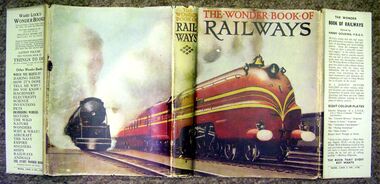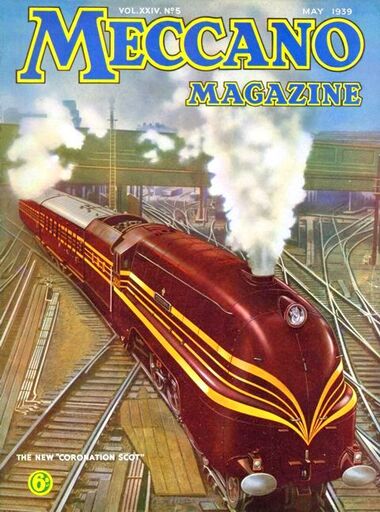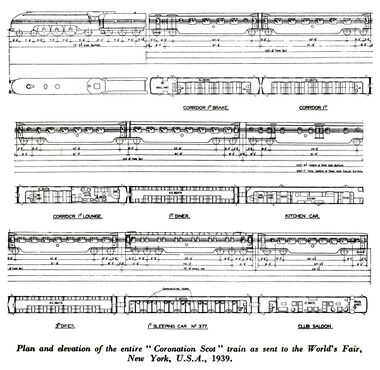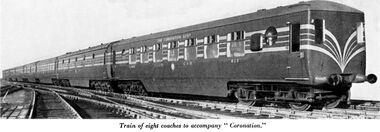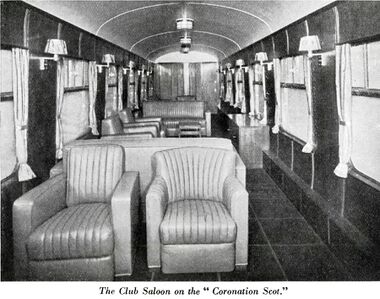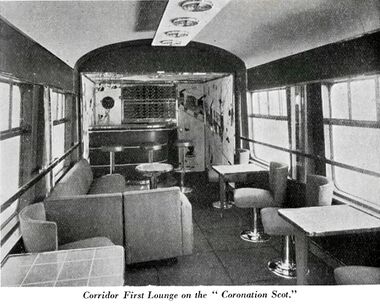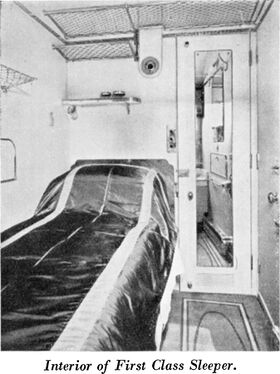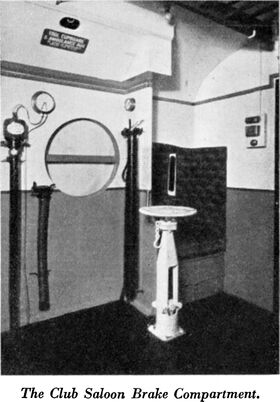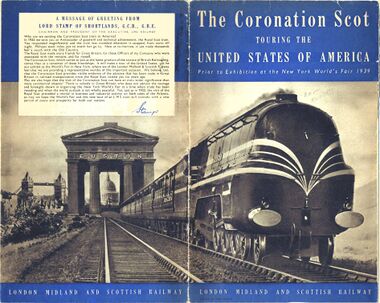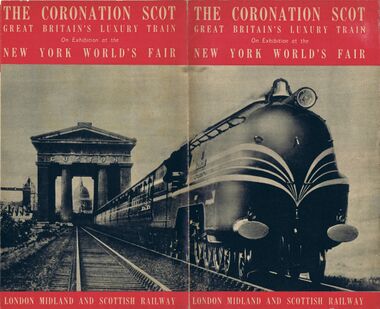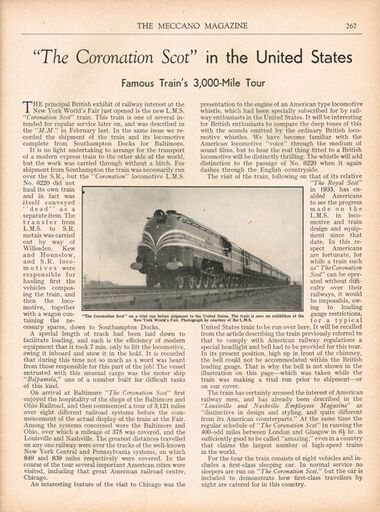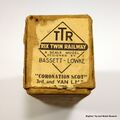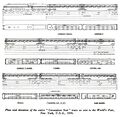Category:Coronation Scot 1939
Cover of The Wonder Book of Railways, showing the red Coronation Scot in the US with bell and headlight, alongside an American locomotive [image info]
1939: Front cover of Meccano Magazine, showing the red 1939 Coronation Scot on UK track, on its way to the docks to be shipped to the US. This image is based on an LMS publicity photo: the locomotive has been fitted with a headlight, but (due to smaller clearances on US lines, has not yet been fitted with its bell, which was attached when it reached the other side of the Atlantic) [image info]
Carriage layout, 1939 "US Tour" Coronation Scot [image info]
Coronation 6220 modified locomotive profile, showing US-regulation headlight and bell [image info]
Coronation US tour train, "special" tail paintwork [image info]
Club Saloon interior, Coronation Scot "US tour" train [image info]
Corridor First Lounge, Coronation Scot "US tour" train [image info]
First Class Sleeper, Coronation Scot "US tour" train [image info]
Club Saloon Brake Compartment, Coronation Scot "US tour" train [image info]
As the first of three new planned red-and-gold carriage sets, the 1939 Coronation Scot train was shipped off to the United States almost as soon as it was completed (after publicity photos), along with the last of the first batch of five red-and-gold streamliners, 6229 Duchess of Hamilton (which swapped numbers and names with Coronation 6220 for promotional purposes).
The 1939 US tour
The early blue version of the tour brochure, printed in advance, in England. Note the use of US spelling and terminology (e.g. "railroad") [image info]
Later printing of the leaflet, themed in red rather than blue, with the main image further doctored to add the US-regulation headlight and bell [image info]
1939: A contemporary (May 1939) Meccano Magazine article about the US tour [image info]
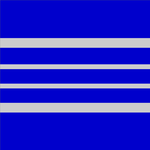
Coronation Scot Exhibition
the locomotives
trains: 1937 - 1939 - 1940
greatest? - streamlining - advertising - trivia - models and kits
The back of the blue LMS publicity brochure for the tour gives a taste of the prevailing mood and the impending threat of war:
A MESSAGE OF GREETING FROM LORD STAMP OF SHORTLANDS, G.C.B., G.B.E.
CHAIRMAN AND PRESIDENT OF THE EXECUTIVE, LMS RAILWAYWhy are we sending the Coronation Scot train to America?
In 1933 we sent you an Ambassador of goodwill and technical achievement, the Royal Scot train. You responded magnificently and the train was crowded wherever it stopped, from morn til night. Millions went miles just to see her go by. New as tomorrow, it yet made thousands feel a touch with the Old Country.
The Royal Scot made many friends for Great Britain, for those Officers of my Company who were associated with the venture, and for myself.
The Coronation Scot, which comes to you as the latest product of the science of British Railroading, comes then as a cementer of these friendships. It will make a tour of the United States, and be our exhibit at the World’s Fair in New York, where we of the London, Midland & Scottish Railway feel that we are providing a representative worthy of this important occasion. We believe, too, that the Coronation Scot provides visible evidence of the advance that has been made in Great Britain in railroad transportation since the Royal Scot visited you six years ago.
May we also hope that the visit of the Coronation Scot can have an even wider significance than mere commercial objects? There is nobody in Britain who does not admire the courage and foresight shown in organizing the New York World’s Fair at a time when trade has been receding and when the world outlook is not wholly peaceful. Yet, just as in 1933, the visit of the Royal Scot preceded a revival in business and industrial activity on both sides of the Atlantic, so may we hope the World’s Fair and this new tour of an L M S train will coincide with a new period of peace and prosperity for both our nations.
March 1939 article, The Model Railway News
The L.M.S.R. and the World's Fair
By courtesy of the L.M.S.R., I am able to publish the illustrations reproduced herewith, showing the new "Coronation Scot" train which the company has sent over to America for exhibition at the World's Fair. The train, consisting of the streamlined locomotive No. 6220 Coronation and eight coaches, was shipped from Southampton Docks on 18th January, in the S.S. Belpamela; and on arrival in U.S.A. was unloaded at Baltimore, and then assembled and made ready for the road in the Baltimore shops of the Baltimore & Ohio Railroad.
An exhibition tour of 38 American cities and towns, covering 3,121 miles (the train travelling under its own power, with eight U.S. railroads and the Federal Interstate Commerce Commission co-operating in the movements) will begin at Baltimore on 21st March and conclude at Hartford and New Haven, Conn., on 14th April.
The train will be on show at the World's Fair, New York, from 30th April to 31st October.
The Train
In the normal course three new train sets would be required in 1940 for the "Coronation Scot " service between Euston and Glasgow, and, in order that the train visiting U.S.A. may be representative of the very latest British methods of design and construction, the completion of the first of the new trains at the L.M.S. Derby Works has been advanced. In the construction of the train, which has been designed by the Company's Chief Mechanical Engineer, Mr. W. A. Stanier, new schemes of colour decoration, upholstery and lighting prepared by Mr. Brian O'Rorke, A.R.I.B.A., have been introduced, whilst constructionally it also represents an important departure, each two-coach unit being built on the articulated principle with three bogies instead of four per two coaches. Light, high-tensile steel has been used throughout the construction in order to provide great strength with light weight, the same object being helped by the large-scale use of welding. Each coach of the two-coach units weighs about 30 tons, compared with 32 to 35 tons of a standard coach.
The vehicles in their order from the locomotive, are Corridor First Class Brake Coach, Corridor First Class Coach, Corridor First Class Lounge (with Cocktail Bar), First Class Diner, Kitchen Car, Third Class Diner, First Class Sleeping Car, and Club Saloon. The sleeping car is not a normal part of the "Coronation Scot's" routine formation, but is being included to demonstrate How night-travellers are catered for on British railways. During the tour, Belfast linen will be exclusively used in the sleeping-car and for the antimacassars in the day coaches. Seating accommodation is 173 in the exhibition train, but will be more in the standard service trains the weight of train without locomotive is 262 tons, and with locomotive 426 tons 9 cwts; total length (including locomotive) about 580 ft. Controllable oil-filtered ventilation is in
use throughout, whilst special features include large double windows to minimise noise and exclude dust, telephones connecting passenger compartments with the restaurant attendant, and the large-scale use of cork and asbestos flooring, lining, etc., to deaden sound and vibration.Locomotive
The locomotive which will haul the "Coronation Scot" throughout its American tour is No. 6220 Coronation, built at the L.M.S. Crewe Works in 1937. This engine weighs over 164 tons in working order, and carries 4,000 gallons of water and 10 tons of coal. At present the "Coronation Scot " train in public service still carries the " Coronation " livery of blue-and-silver, but the train for America is in the standard L.M.S. livery of lake (with gold horizontal bands), the engine having been repainted in this livery to conform to the revised colour-scheme. Both engine and train are fully streamlined. The form of streamlining was finally decided upon after very careful experiments with models in the L.M.S. Research Department's wind tunnel at Derby, the tests being carried out to represent both head winds and winds crossing the track at various angles.
Personnel
The train will be accompanied on its tour by Col. K. R. N. Speir (Overseas & Continental Traffic Assistant to Chief Commercial Manager, L.M.S.R.), and Mr. R. A. Riddles (Mechanical & Electrical Engineer, Scotland).
Manning the engine throughout the tour will be 57-years' old bachelor F. C. Bishop, of Camden (London), who has been a driver for 24 years and who drives the "Coronation Scot," the "Royal Scot," and (on occasion) the Royal Train. His fireman is 34-years' old J. McKinnon Carswell, a native of Scotland, who is also stationed at Camden. Driver Bishop has 41 years' service, Fireman Carswell 18; the latter is passed to act as driver if required.
Also accompanying the train from a maintenance point of view, is Mr. F. A. Soden (36) of Crewe, who is a Foreman in the Erecting Shop at Crewe Locomotive Works, and whose designation whilst in U.S.A. will be Master Mechanic.
— , By J. N. MASKELYNE, A.I.Loco.E., , The Model Railway News, , March 1939
May 1939 article, Meccano Magazine
"The Coronation Scot" in the United States
Famous Train's 3,000-Mile Tour
THE principal British exhibit of railway interest at the New York World's Fair just opened is the new L.M.S. "Coronation Scot" train. This train is one of several intended for regular service later on, and was described in the "M.M." in February last. In the same issue we recorded the shipment of the train and its locomotive complete from Southampton Docks for Baltimore.
It is no light undertaking to arrange for the transport of a modern express train to the other side of the world, but the work was carried through without a hitch. For shipment from Southampton the train was necessarily run over the S.R., but the "Coronation" locomotive L.M.S. No. 6220 did not haul its own train and in fact was itself conveyed dead as a separate item. The transfer from L.M.S. to S.R. metals was carried out by way of Willesden, Kew and Hounslow, and S.R. locomotives were responsible for hauling first the vehicles composing the train, and then the locomotive, together with a wagon containing the necessary spares, down to Southampton Docks.
A special length of track had been laid down to facilitate loading, and such is the efficiency of modern equipment that it took 7 mm. only to lift the locomotive, swing it inboard and stow it in the hold. It is recorded that during this time not so much as a word was heard from those responsible for this part of the job! The vessel entrusted with this unusual cargo was the motor ship "Belpamela," one of a number built for difficult tasks of this kind.
On arrival at Baltimore "The Coronation Scot" first enjoyed the hospitality of the shops of the Baltimore and Ohio Railroad, and then commenced a tour of 3,121 miles over eight different railroad systems before the commencement of the actual display of the train at the Fair. Among the systems concerned were the Baltimore and Ohio, over which a mileage of 375 was covered, and the Louisville and Nashville. The greatest distances travelled on any one railway were over the tracks of the well-known New York Central and Pennsylvania systems, on which 849 and 839 miles respectively were covered. In the course of the tour several important American cities were visited, including that great American railroad centre, Chicago.
An interesting feature of the visit to Chicago was the presentation to the engine of an American type locomotive whistle, which had been specially subscribed for by railway enthusiasts in the United States. It will be interesting for British enthusiasts to compare the deep tones of this with the sounds emitted by the ordinary British locomotive whistles. We have become familiar with the American locomotive "voice" through the medium of sound films, but to hear the real thing fitted to a British locomotive will be distinctly thrilling. The whistle will add distinction to the passage of No. 6220 when it again dashes through the English countryside.
The visit of the train, following on that of its relative "The Royal Scot" in 1933, has enabled Americans to see the progress made on the L.M.S. in locomotive and train design and equipment since that date. In this respect Americans are fortunate, for while a train such as "The Coronation Scot" can be operated without difficulty over their railways, it would be impossible, owing to loading gauge restrictions, for a typical United States train to be run over here. It will be recalled from the article describing the train previously referred to that to comply with American railway regulations a special headlight and bell had to be provided for this tour. In its present position, high up in front of the chimney, the bell could not be accommodated within the British loading gauge. That is why the bell is not shown in the illustration on this page—which was taken while the train was making a trial run prior to shipment—or on our cover.
The train has certainly aroused the interest of American railway men, and has already been described in the "Louisville and Nashville Employees Magazine" as "distinctive in design and styling, and quite different from its American counterparts." At the same time the regular schedule of "The Coronation Scot" in running the 400-odd miles between London and Glasgow in 6 hr. is sufficiently good to be called "amazing," even in a country that claims the largest number of high-speed trains in the world.
For the tour the train consists of eight vehicles and includes a first-class sleeping car. In normal service no sleepers are run on "The Coronation Scot," but the car is included to demonstrate how first-class travellers by night are catered for in this country.
— , -, , The Coronation Scot in the United States, , Meccano Magazine, , May 1939
1942 'Railways' article
The "Coronation Scot" in U.S.A.
(These notes were set before the announcement of the return of the "Coronation Scot" locomotive from the States).
Last summer there was some interesting correspondence in the American railway Press concerning the Coronation Scot locomotive and train now stored at Baltimore. Writing to the "Railroad Magazine" a reader suggested that a tour of the U.S.A. might be made with this train, and proceeds from the gate money given to British relief funds. But Mr. Dwight Fullerton, of Chicago, in a letter to Mr. 0. S. Nock outlines some considerably more ambitious proposals. "You know," he writes, "I think this train could be sold to some road here for more money than she will be worth to take home, and be out of date when she gets there. Let the Pennsylvania have her for one of the Detroit hot-shots. How they could leg it to Fort Wayne with that little job— 'The Refugee Scot for Detroit leaves Union Station, Canal and Adams Street every morning 9.15; tea, cakes, muffins, marmalade, hot meat pies, 85 cents.' Yes, she would turn people away every morning. All you need is some good advertising plugging. The Railroad fans would pawn their shirts!
Another nice spot for her would be the little Monon Route, the Chicago, Indianapolis and Louisville Ry. ; ex-Dearborn Street every morning for French Lick, Indiana; or again on the Pere Marquette, around to Holland, Michigan."
These are most interesting suggestions. So far as the crack Pennsylvania expresses to Detroit are concerned the L.M.S. Pacific Coronation should not find any difficulty in working the 350-ton "Detroit Arrow," which is booked to cover the 140.9 miles from Englewood (Chicago) to Fort Wayne in 115 minutes. We can think of many ways in which, reciprocating the Lease-Lend policy, she could play an active part in the Allied war effort.
— , -, , Railways Magazine, , March 1942
Modifications
The makeup of the 1939 train was a little different to the other two planned "red" sets, and consisted of eight cars, six of which were in twinned pairs with shared bogies.
Compared to the blue 1937 trains, the most obvious external differences were the shared-bogie carriages, circular end-side windows on some of the cars, and the addition of a "skirt" or valance that smoothly extended the carriage sides down between the wheel-sets (and hid some of the under-carriage "gubbins".
The end cars also had slightly rounded-off rear edges, no rear door, and a "hamster-tail" paint-job that extended the gold side stripes to meet at a small central chevron that mirrored the gold "whiskers" on the locomotive's nose.
The "hamster-tail" wasn't an entirely convincing nod to streamlined design, but it was at least better than having the train end abruptly. The hamster-tail carriages complicated later reuse on the BR network, as they prevented passengers and staff from being able to travel along the full length of a train, when a repurposed "hamster" had been used for one of the middle cars.
The sleeper car
The other notable difference on the American train, other than the club car and bar, was the existence of a sleeper car. A sleeper car wasn't included in the "normal" Coronation Scots, because the entire journey from London to Glasgow only took a little over six hours. A sleeper car was more useful when the train was covering the far longer distances across the US, it was something that US audiences expected to see, and it also meant that, at a pinch, the crew were guaranteed to always have somewhere to sleep as they travelled across a foreign country.
The war years
When war broke out, the full "red" train was stranded on the wrong side of the Atlantic, with the carriages used for a while for US Army accommodation after the tour ended. The locomotive was shipped back to the UK during the war since it had a role to play in the war effort, but returning the carriages wasn't as high a priority, so they weren't shipped back until after the war was over.
References
- G.M. Kitchenside, The "Coronation Scot" train sets of the LMS, article, Railway World, September 1964 issue
Pages in category ‘Coronation Scot 1939’
The following 3 pages are in this category, out of 3 total.
Media in category ‘Coronation Scot 1939’
The following 18 files are in this category, out of 18 total.
- 1939 New York Worlds Fair Coronation Scot brochure red.jpg 2,137 × 1,740; 1.14 MB
- 1939 pre New York Worlds Fair Coronation Scot brochure blue.jpg 1,889 × 1,508; 486 KB
- Box end label for Coronation Scot carriage (Trix Twin Railway).jpg 800 × 799; 381 KB
- Club Saloon Brake Compartment, Coronation Scot US tour (MRN 1939-03).jpg 836 × 1,200; 173 KB
- Club Saloon, Coronation Scot US tour (MRN 1939-03).jpg 1,200 × 944; 312 KB
- Coronation loco 6220, US tour, profile (MRN 1939-03).jpg 2,400 × 711; 324 KB
- Coronation Scot cap-badge.jpg 800 × 335; 55 KB
- Coronation Scot in the United States.jpg 1,205 × 1,624; 428 KB
- Coronation Scot US (MRN 1939-03).jpg 2,400 × 2,339; 729 KB
- Coronation Scot US, special coaches (MRN 1939-03).jpg 2,400 × 834; 355 KB
- Corridor First Lounge Coronation Scot US (MRN 1939-03).jpg 1,200 × 960; 310 KB
- Interior of First Class Sleeper, Coronation Scot US tour (MRN 1939-03).jpg 898 × 1,200; 194 KB
- MeccanoMagazine May1939 NewCoronationScot.jpg 480 × 647; 91 KB
- TTR catalogue 1939-40 cover.jpg 1,722 × 2,820; 816 KB
- TTR Coronation Scot 1939 red US tour set.jpg 1,717 × 2,832; 643 KB
- Wonder Book of Railways (Coronation Scot), dustjacket.jpg 2,497 × 1,208; 638 KB
- Wonder Book of Railways (Coronation Scot), front.jpg 1,700 × 2,170; 543 KB
